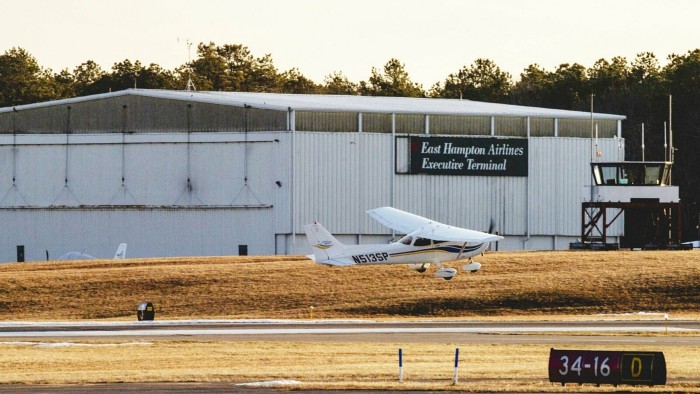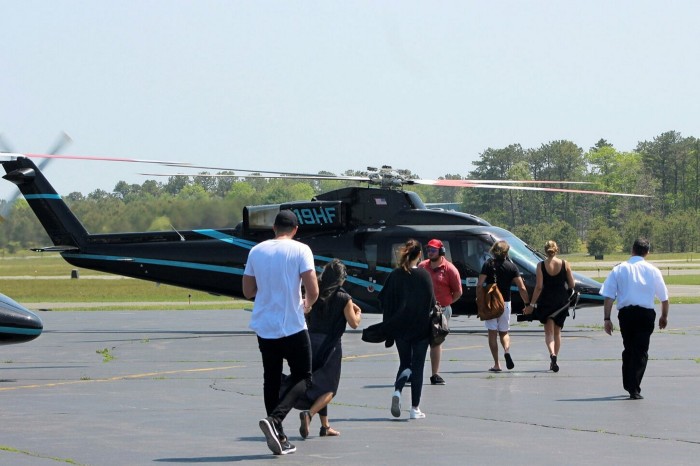Tensions fly high in East Hampton airport drama


Roula Khalaf, Editor of the FT, selects her favourite stories in this weekly newsletter.
Ah, summer in New York. A time for intense temperatures, heady romance and action-packed blockbuster films. But this season’s biggest drama is playing out on the tarmac at East Hampton airport, a two-and-a-half-hour drive east of Manhattan (four if you hit rush hour, six if it’s a holiday weekend).
The desire to avoid crawling car traffic to luxury Hamptons retreats “Out East” has fuelled a showdown over the proposed closure of the airport. By air, Manhattanites can reach East Hampton in under 45 minutes.
But some Hamptons residents say that the noise from a boom in private air travel is intolerable. This summer, a years-long battle came to a head when the airport was slated for closure on May 17 in order to be taken private by the town, which would allow for control over operations. The airport has been temporarily held open and remains public without restrictions — following an emergency restraining order and pending a judge’s ruling.
Between May and September each year, the population of East Hampton explodes from about 22,000 to an estimated 90,000. Queues in grocery stores stretch as the “summer people” arrive to enjoy pristine beaches, cooler temperatures and the absence of the city’s hot-trash smell.
In 2019, 31,000 flights landed at East Hampton airport, with the vast majority — 75 per cent — concentrated in the summer months, according to town data. The 2019 figure was up 21 per cent on 2015, largely driven by an increase in helicopter landings, which increased by 42 per cent over the period.
Commercial helicopter airlines, such as Blade, have helped bring the outrageous convenience of private travel from the 0.1 per cent to the wider 1 per cent. A seat to East Hampton will cost you about $1,000 one way.

While the battle has been raging over East Hampton airport for years, scrutiny intensified during the pandemic as city dwellers fled to their luxury beachside boltholes to weather the storm.
The number of complaints had already risen, to 47,000 in 2019 from 19,000 four years earlier, mostly from properties on the flight path. Complaints came from 553 households, with a few logging more than 1,000. Helicopter traffic is overrepresented, accounting for 53 per cent of noise complaints, despite making up just 30 per cent of landings at the airport, according to town data.
Conflict between Long Island locals and more affluent, and transient, summer people, is a tale older than Gatsby. But the airport debate is not so simple. Local businesses don’t want to stymie the spending of literal high flyers, while summer people don’t appreciate the relentless chopping of elevator blades over their beach homes.
The environmental impact of all the private air travel is a concern, while helicommuters fear the end of the ride-share party. Advocates for the airport remaining open say it is vital for the local community to have access to an airport for medical evacuations.
The town of East Hampton has been hit with several lawsuits over its attempt to shut the airport, and the battle has been heated. (“I’ve never seen a case with more motions,” said one aviation lawyer involved in the airport dispute.) “Eighty per cent of the town wants the airport to stay open, with restrictions on things like schedules,” says Andy Sabin, a pro-airport Hamptons resident and plaintiff in one of the lawsuits against the town. “But we have the wackadoos out here. If you don’t like rich people, go to Venezuela or Cuba and you don’t have to worry about it any more.”
Peter Van Scoyoc, the town supervisor and a named defendant in a lawsuit brought by Blade, and his office did not respond to requests for comment.
Supporters of the airport say time is money. A study last year by the East Hampton Community Alliance (EHCA) calculated that flying may actually be the cheapest option compared with bus or train, based on a person valuing their time at $400 an hour, which is then multiplied by the travel time and added to the ticket price. However, the reality is that flyers must place an even higher value on their time — turboprop jets can be hired starting from around $12,000 return, according to Evojets.
Because of this budget paradox, airport supporters say closing East Hampton will displace traffic to other airports. Residents of Montauk, 20 miles away, are not pleased.
The EHCA believes that a set of proposals to mollify East Hampton residents, such as curfews on flight times, would affect just 13 per cent of air travel to the airport but address 38 per cent of complaints. Other proposals, such as limiting commercial operations like Blade, or particularly loud planes, to one flight a day, are much less popular with flight-share companies. And while the community group feels that the town and pro-airport groups are in agreement on the majority of issues at this stage, they said that the fighting has become so bitter that compromise feels increasingly out of reach. Fabulous local newspaper coverage of the battle is worth seeking out in lieu of a beach read this summer.
For now, the airport remains open pending a judge’s decision, and tensions are running high. In the meantime, it’s still summer in the Hamptons and — as a friend of mine likes to say — “There’s no crying at the beach house.”
Madison Darbyshire is the FT investment reporter based in New York. Follow Madison on Twitter @MADarbyshire
This article is part of FT Wealth, a section providing in-depth coverage of philanthropy, entrepreneurs, family offices, as well as alternative and impact investment
Comments